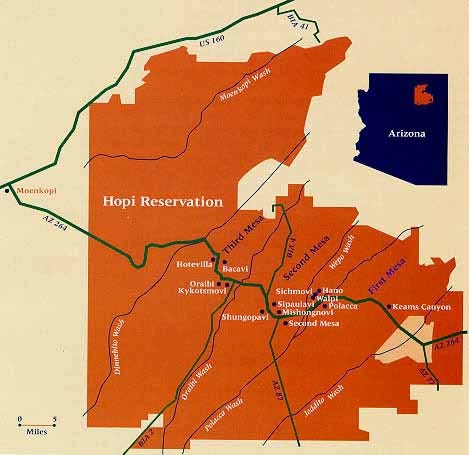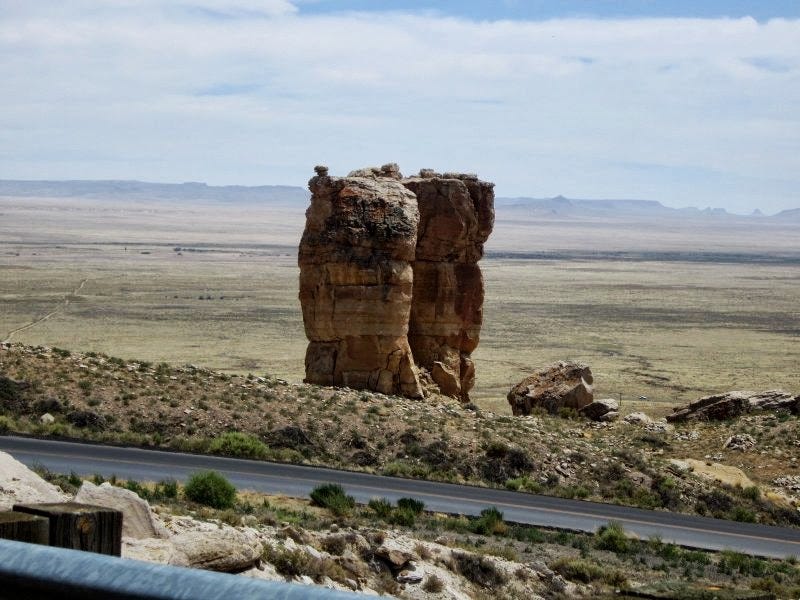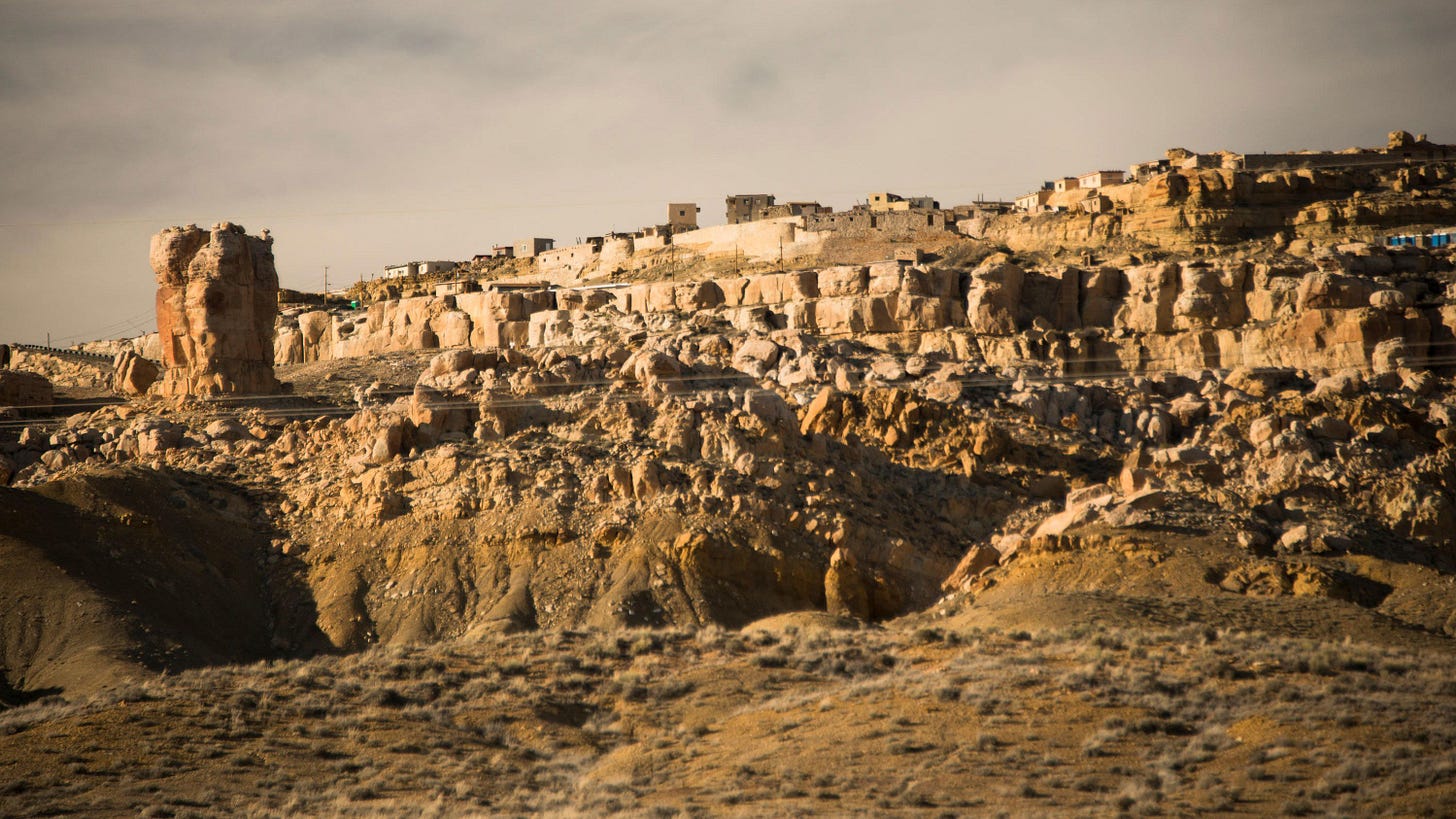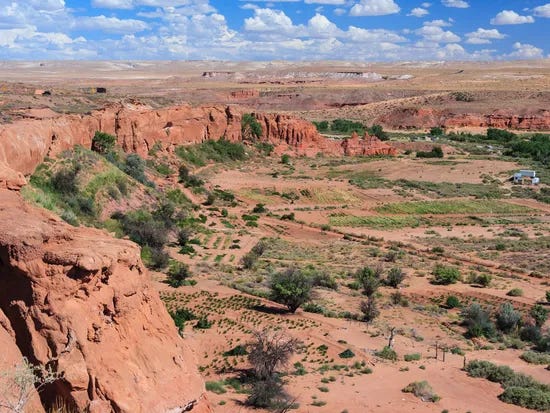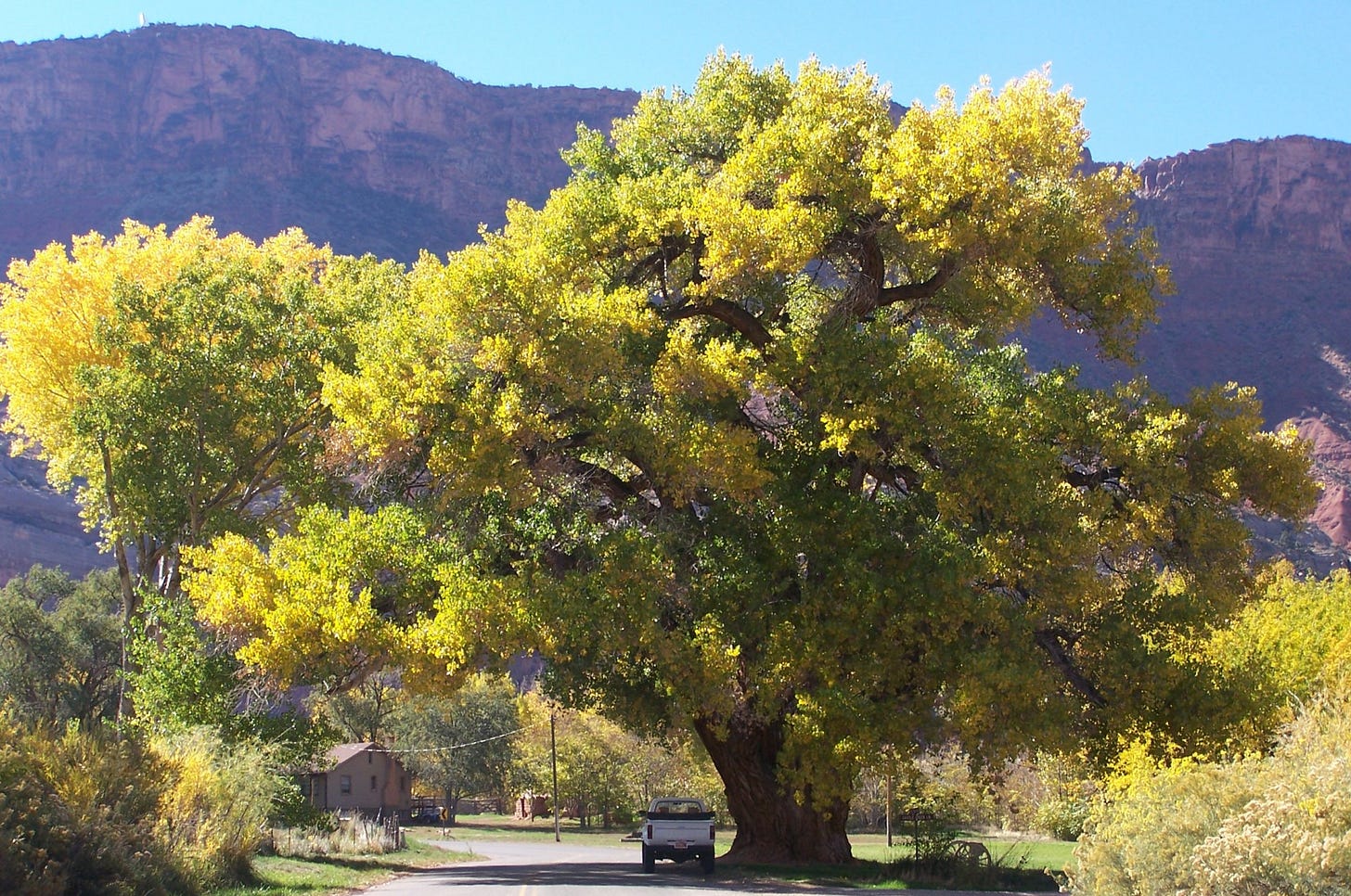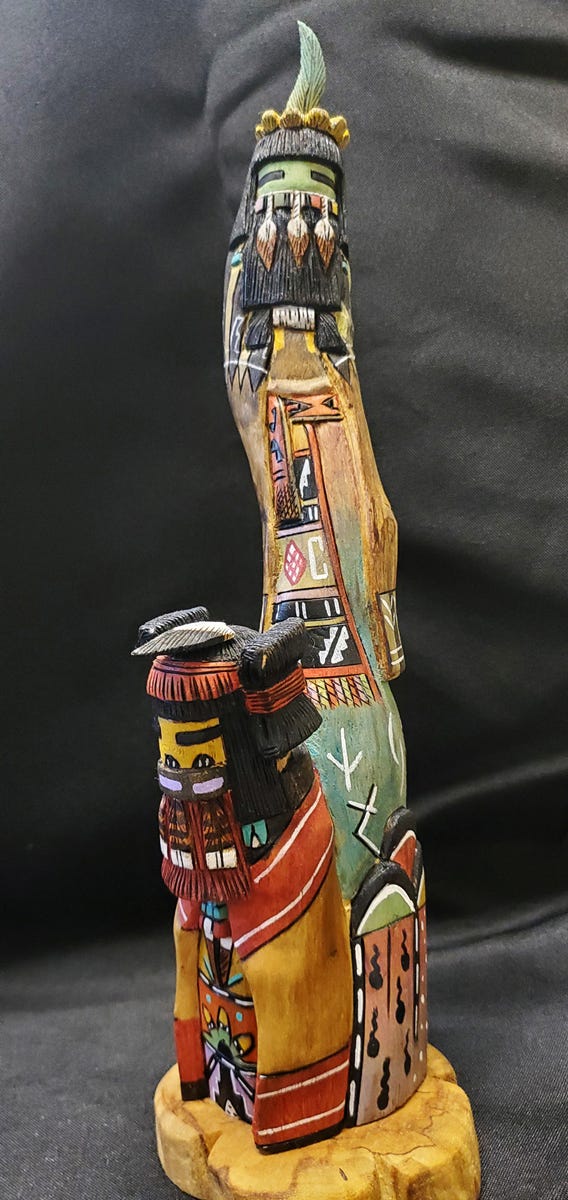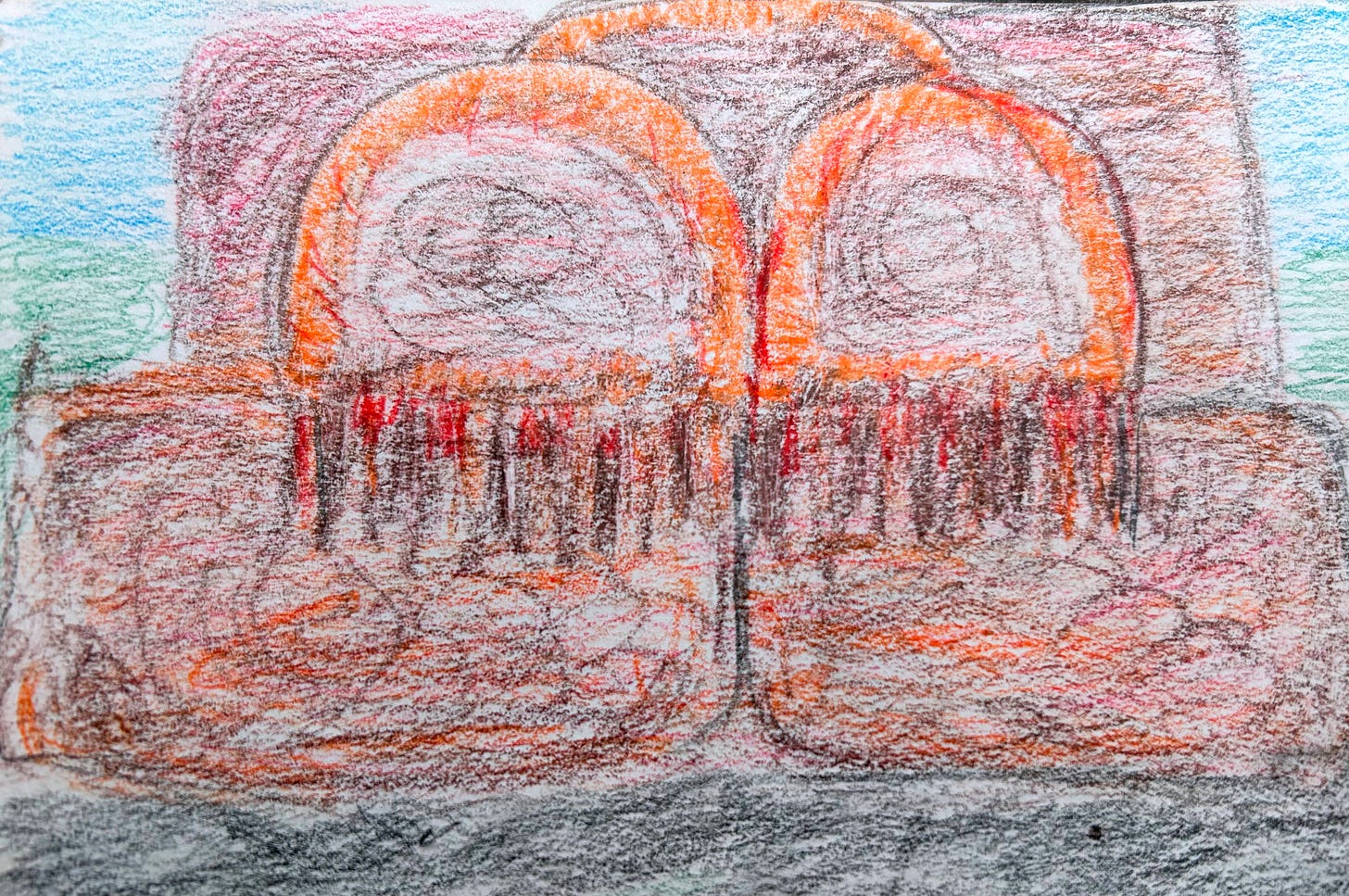The Hopi Story of Origin
Part II Cultural Orientation with Ron Awakens Unknown Dimensions for me
As you can see from the map above, Second Mesa is basically a grocery and hardware store, the main Post Office, and one neighborhod of local Hopi residents nearby on the right side of the road. The BIA compound on the left side of highway 60 includes the cinder block cluster of houses for BIA teachers, and the brick school house with some trailers for offices. To enter the BIA compound, one turns left off of 60 onto 264 and then left again at the first driveway entrance.
Across the blacktop 264 road from the BIA compound resides two of the three villages that make up what is called Second Mesa. The rustic rock structures of these two villages are made by nature and a people in tune with nature.
Standing in my backyard, looking up from the BIA housing in the morning, I can see what appears in the bright sunlight a monolith of beige and rusty sandstone jutting out into the bright blue sky. The villages above and beyond the double rock formation spiral ancient stone structures. From down below where I am at ground level, in the sunshine. the layered villages appear as a magical rustic stone ship.
On the way to the two villages ‘up top’, stand two sisters, living rocks sculpted from nature’s elements. Water, wind, lime and golden and red sandstone hewn together by nature. When it rains, the variegated layers of rock are more pronounced.
Beyond ‘the twins’, the black top road turns to dirt as it hairpins around each layer of the mesa. First Shipaulovi and then Mishongovi villages spiral up to the top of the mesa. These two villages are where some of my students live in community with silversmiths, kachina carvers and people struggling with sobriety and meaning. As I continue driving up top, sheep herders, snake dancers and corn farmers reside close together; many families live in stone houses without electricity or running water.
Along the drive east of Second Mesa, I come to Keams Canyon where the BIA headquarters is located. This is the far eastern boundary of the Hopi reservation. Craning my neck to see where the Hopi blue corn was planted, there are no rows of tall corn stalks planted close together with obvious tassels visible. I can’t imagine watermelons, cantaloupe, tomatoes, peppers or corn growing anywhere on this high desert terrain with sparse housing and vegetation in between the three mesas that embody the heart of Hopi. The Hopi farmers chant, dance and pray for rain.
In their language, Hopi means peace.
After completing my application for school counseling, I find out when I turn it in, there’s a requirement to take a week long class to acclimate mainly white people to the culture and traditions of this unique native people.
“The Hopi are the oldest continuing civilization on this continent that we know of. The Mayan, the Aztecs, the Mound Builders- all these ancient people have ended. The Hopi continue according to Hopi tradition; there have been previous worlds — not separate worlds, but the same world with different civilizations on it.
“First World was destroyed, Second World came into being and eventually certain people ruled it. The Hopi prophecy didn’t mean the whole planet was destroyed; it meant that the civilization and way of life were changed.
“There are differing versions of oral history. One origin tradition says the Hopi came up from a different continent. The other says they came from a hole in the Earth.
“The first tradition speaks of a high level civilization on the missing continent but this high civilization destroyed that world. This sect of Hopi say the Katsina people, the star people, came and saved a portion of this civilization from catastrophe.
“Second tradition speaks of the Hopi coming up from underground seems to start at this point in the historical narrative. They traveled North and were greeted by the great Eagle who gave a message they were never to build cities.
“Before they could reach ground to live, even though given tablets showing where this final place was, each clan would be given a different ceremony to fulfill. Each ceremony, necessary to survival, If they didn’t follow the ceremony and prayers, they would destroy themselves.” 1
The Hopi prophecies were introduced by Ron during the BIA training to work with the Hopi culture. He’s employed by the BIA, to conduct the cultural education for new staff. Ron dresses conservatively in dark dress pants, and a professional looking belt.
“The Hopi were survivors of another world that was destroyed. Therefore, Hopi were here first and made four migrations-North, South, East, and West-claiming all the land for the Great Spirit, as commanded by Massau, and for the True White Brother who will bring on Purification Day.”
—Chief Dan Katchongva, Sun Clan Hopi Sovereign Nation
The main Hopi village Polacca, on first mesa, is where settling deer and hummingbird clans allowed the Tewa tribe to live down below the towering stones to serve as their protectors from marauding tribes including Catholic priests. Three Spanish priests raped the local Hopi and Tewa young women. The offenders were strung up by the tribes and hung in the 1800s in this Keams Canyon area where the BIA administrative buildings are located now.
The story of the priests being hung near their parish in Keams Canyon was one mentioned during the cultural orientation workshop ba’hanas (white people like me) were required to attend before working on the Hopi reservation. Ron’s seriousness during the cultural orientation came through when he spoke of the Hopi Prophecy. He emphasized the transition from the fourth world we are in now into the fifth world in the near future.
A lot of this didn’t make sense to me at the time. However, I could sense that this was the crux of the Hopi way of life and spiritual beliefs. From my year and a half on Navajo, I surmised Hopi values were similar to yet not the same as the Beauty way of the Navajo culture.
“Those from the Center make us unite. The Eagle of the North and the Condor of the South. We will meet with our Relatives because we are One, as the fingers of our hand.”
— Hopi Prophecy
I find the Hopi origin story fascinating and some say this ancient culture may have come up from South America. The origin myth of the Hopi explained they believed they came from the ant people who lived underground. The location where they had first come from the spiral world underground was believed to be located at the base of the North Rim of the Grand Canyon.
“Native Wisdom keepers around the word speak of our origin from the Star Nations. Their influence on functions of ceremony, culture, and traditions. As humanity stands at the crossroads between the Fifth and Sixth Worlds, the emergence of peace is upon us, the Hopi call this the Time of Peace. They recognize the signs that they must now speak their original instructions from the Sky Elders.”
—Nancy Red Star, Star Ancestors, Extraterrestrial Contact in the Native American Tradition
Huge Cottonwood Tree in Castle Valley, Utah near Moab, 2005
After completing the training, I drive around to see the old cotton wood trees, similar to the ones I’d grown up with along Sand Creek in Newton, Kansas. Shuddered inside when I pass a couple of trees that had branches high and thick enough to hang grown men along a wash, a long dried out sandy rivulet bed that became a small river during heavy rains.
Ron mentions to me privately that the kachina dolls the Hopi carve are mainly carved out of cottonwood.
Ron points — mainly with his lips, which was I noticed something many Hopi do — to where the source of the sweet well water is as we drive up the steep curvy road to his family’s village. I drive slow to see the reddish toned stones formed in the shape of one cloud over two clouds with rain markings below the clouds. Like a tattoo in the surface of the sandy limestone rocks. I love the Hopi sense of humor and am happy to find a t-shirt in a gift shop, saying “Don’t Worry, Be Hopi”.
Hopi well markings sketch to honor and respect Hopi village privacy
Current Crone Wisdom:
For me, as an elder now, nearly forty years after this story of my time on Hopiland began, I felt when I was thirty-six, an inner calling to be and live on native land after graduating from ASU with two masters degrees. After Mother died and subsequent family silence, there’s a deep longing to connect with my true kin, with nature and with a more natural way of being and living.
Some could say it sounds like I’m idealizing indigenous people. And the truth is that I am celebrating a kind of purity and simplicity of the Hopi way of life, away from the trappings of dominant culture.
I lived in this area of northern Arizona for close to five years, I am well aware of the challenges there: addiction, poverty, clan jealously, rivalry in a small community, and emotional, sexual abuse. I will write more about this as it unfolds in the next two parts of this three part series.
It is my heart to share with you about my time on Hopiland as a heart-centered counselor. I feel an ever deepening appreciation, gratitude and tenderness for a beautiful grounded people who welcomed me on the inner with special spirit dancers, similar to the ones at Ganado on Navajo.
The dream of the yei be chei dancers a year ago and the current visionary or sensory perception felt tangible to me. Holograms of light and sound that I was able to encounter a field of awareness that opened up my ability to feel, see and perceive multiple dimensions.
Hopi gifts still live in me daily. Giving counsel to children and holding healing space for families in tandem to their rich living culture, invited to certain ceremonies and dances for rain, the simple quiet life close to nature nourished and nurtured my heart. I treasure the time I lived and served here, and hold tenderly each precious pure heart with respect and sensitivity.
Mali Keating’s interview, Law of Light- Sound, We Wander this World With a Purpose, Star Ancestors with Nancy Red Star.




